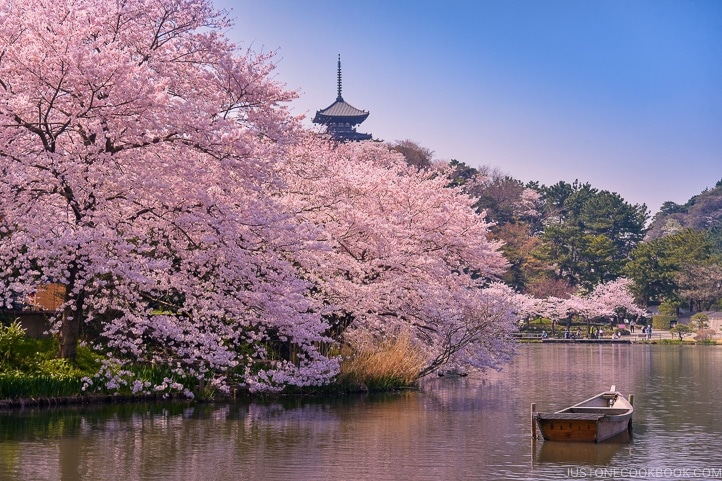The best times to visit Japan are in spring (March to May) and autumn (September to November). During these seasons, you can experience the cherry blossoms and colorful foliage, respectively, and the weather is mild.
In summer, Japan can be hot and humid, while winter brings cold temperatures and snow, especially in the northern regions. Keep in mind that popular tourist spots can be crowded during cherry blossom season and during the Golden Week holiday in late April and early May.
To avoid the crowds and higher prices, consider visiting Japan during the shoulder seasons of late spring and early autumn.

Credit: www.justonecookbook.com
Japan: Overview Of Seasons And Climate
A visit to Japan promises an array of fascinating cultural experiences, delicious cuisine, and breathtaking natural landscapes throughout the year. To make the most of your trip, it’s essential to consider the seasonal variations and climate of the country. From cherry blossoms in spring to vibrant foliage in autumn, each season offers a unique charm. Understanding the overview of Japan’s seasons and climate can help you decide the best time to visit this captivating destination.
Brief Introduction On Japan’s Seasonal Attributes
Japan experiences four distinct seasons – spring, summer, autumn, and winter – each characterized by its own set of attractions and activities. The country’s diverse topography contributes to the varied climatic conditions across its regions. From the snowy mountains of Hokkaido in the north to the temperate beaches of Okinawa in the south, visitors can experience a wide range of weather patterns.
Weather Variations In Different Regions
The weather in Japan varies significantly based on the region and time of year. This geographical diversity allows travelers to explore tropical beaches, alpine ski resorts, and lush countryside landscapes, all within the same island nation. By understanding the weather patterns across different regions, you can plan your itinerary to make the most of the climate that suits your preferences.
Best Time To Visit Japan
When planning a trip to Japan, it’s crucial to consider the best time to visit to make the most of your experience. Each season in Japan offers something unique and captivating, making it a year-round destination for travelers.
Spring: Cherry Blossom Festival
Spring in Japan, particularly in late March to early April, brings forth the iconic cherry blossom season. The ethereal beauty of the cherry blossoms, or ‘sakura’, is a sight to behold, painting the landscape in hues of pink and white. Visiting during this time allows you to partake in hanami, the traditional custom of enjoying the blossoms, as well as attending various cherry blossom festivals held across the country.
Summer: Festivals And Beaches
Summer in Japan offers a myriad of vibrant festivals, such as the Gion Matsuri in Kyoto and the Nebuta Matsuri in Aomori. The energetic atmosphere and cultural displays during these festivals provide a glimpse into Japan’s rich heritage. Additionally, Japan’s coastal regions boast stunning beaches, offering a perfect retreat from the summer heat.
Fall: Autumn Foliage
As the leaves begin to change, Japan’s landscapes transform into a mesmerizing canvas of red, yellow, and orange hues. Witnessing the breathtaking autumn foliage, known as ‘koyo’, is a popular pastime during the fall months. Exploring picturesque gardens, temples, and scenic spots engulfed in vibrant foliage is an unforgettable experience.
Winter: Skiing And Onsen
Winter in Japan presents opportunities for adventurous pursuits such as skiing and snowboarding in renowned resorts like Niseko and Hakuba. Furthermore, indulging in the tranquil relaxation of onsen, traditional Japanese hot springs, offers a soothing escape from the winter chill. The snowy landscapes and serene onsen make winter an enchanting time to visit Japan.
Travel Tips For Visiting Japan
Japan has the top tourist spots in Asia. When planning a trip to Japan, it’s essential to be well-prepared for the unique cultural experiences and diverse weather conditions that the country offers. Here are some essential travel tips for visiting Japan that will help you make the most of your trip.
Packing Guide For Different Seasons
Japan experiences four distinct seasons, with each season bringing its own charm and challenges. When packing for your trip, consider the weather conditions during the specific time of your visit. Here’s a general packing guide for each season:
| Season | Packing Essentials |
|---|---|
| Spring (March to May) |
|
| Summer (June to August) |
|
| Fall (September to November) |
|
| Winter (December to February) |
|
Cultural Norms And Etiquette
Japan has a rich cultural heritage, and it’s essential to be mindful of the local customs and etiquette during your visit. Here are some key cultural norms and etiquette to keep in mind:
- Bow as a sign of respect when greeting others.
- Remove your shoes before entering someone’s home or certain traditional establishments.
- Avoid public displays of affection and be mindful of personal space.
- Try to use chopsticks properly and avoid sticking them upright in food.
- Always wait for others to start eating before you begin your meal.
Transportation And Accommodation Options
Japan offers a well-connected and efficient transportation system, including trains, subways, and buses. There are various accommodation options, ranging from traditional ryokans to modern hotels. Consider the following tips:
- Purchase a Japan Rail Pass for unlimited travel on JR lines.
- Stay in a ryokan to experience traditional Japanese hospitality.
- Book accommodation in advance, especially during peak travel seasons.
- Consider staying in a capsule hotel for a unique and budget-friendly experience.
Event And Festival Calendar
Japan is a country rich in culture and tradition, and one of the best ways to experience this is by attending its various events and festivals. The event and festival calendar in Japan is packed with vibrant and colorful celebrations that showcase the country’s heritage. Whether you’re interested in cherry blossom festivals, traditional dances, or lively summer events, Japan has something for everyone.
Major Events And Festivals By Season
Spring
- Cherry Blossom Festivals: From late March to early April, the whole country celebrates the blooming of cherry blossoms with hanami (flower viewing) parties.
- Golden Week: A series of public holidays from late April to early May, marked by various events and celebrations across the country.
Summer
- Gion Matsuri: Held in Kyoto throughout July, this festival features processions, parades, and traditional events.
- Tanabata Matsuri: Celebrated in various cities in July and August, this festival honors the romantic legend of the star-crossed lovers Orihime and Hikoboshi.
Fall
- Jidai Matsuri: A historical parade in Kyoto in October, showcasing the different periods of Japanese history through costumes and ceremonies.
- Meiji Shrine Autumn Festival: In November, this festival celebrates the autumn season with traditional music, dance, and food at one of Tokyo’s most famous shrines.
Winter
- Sapporo Snow Festival: Held in February, this iconic winter event features stunning snow and ice sculptures, attracting visitors from around the world.
- Hatsumode: On New Year’s Day, Japanese people flock to shrines and temples to pray for good luck and success in the coming year.
Off-peak Travel Benefits
When planning a trip to Japan, considering off-peak travel times can offer numerous benefits that enhance your overall travel experience. From more affordable accommodations and flight options to less crowded tourist attractions, traveling during the off-peak seasons can elevate your Japan adventure while saving you money and providing a more relaxed and immersive experience.
Cheaper Accommodation And Flight Options
One of the significant advantages of traveling to Japan during the off-peak season is the availability of cheaper accommodation and flight options. During these times, hotels and airlines often offer discounted rates and special promotions to attract travelers. Additionally, you may find more availability and a wider selection of accommodations, giving you the opportunity to book your preferred choices at lower prices.
Less Crowded Tourist Attractions
Visiting Japan during off-peak times means you can explore the country’s renowned tourist attractions with fewer crowds. This allows you to fully immerse yourself in the beauty and history of each location without feeling rushed or overwhelmed by the masses of tourists typically present during peak seasons. You can savor the tranquility of iconic landmarks, enjoy more personal interactions with locals, and capture stunning photos without the distraction of large crowds.
Frequently Asked Questions On When To Visit Japan: Best Times And Travel Tips
When Is The Best Time To Visit Japan?
The best time to visit Japan is during spring (March to May) and autumn (September to November) when the weather is mild and the cherry blossoms or fall foliage are in full bloom.
What Are The Peak Travel Seasons In Japan?
The peak travel seasons in Japan are during cherry blossom season in spring and autumn for fall foliage. These seasons attract large crowds and accommodation and transportation prices tend to be higher.
What Are Some Travel Tips For Visiting Japan?
When visiting Japan, it’s important to learn some basic Japanese phrases, be mindful of customs like bowing and removing shoes indoors, and familiarize yourself with the public transportation system to make getting around easier and more efficient.
Final Thought
The best time to visit Japan is in spring or autumn when the weather is pleasant, and the cherry blossoms or autumn foliage are in full bloom. Plan your trip around these seasons to maximize your experience. Whether you’re exploring the historic temples, bustling cities, or serene countryside, Japan offers something for everyone year-round.
Don’t miss out on the diverse experiences this incredible country has to offer!




